PY4103 Presentation: Traditional Family Impact on Children
VerifiedAdded on 2023/01/16
|12
|863
|28
Presentation
AI Summary
This presentation explores the advantages of children growing up in a traditional family structure, also known as a nuclear family, as opposed to non-traditional family structures. It defines traditional family structure as involving two married individuals and their biological offspring, providing care and stability. The presentation highlights the benefits of traditional families, such as consistency, stability, and financial security, leading to positive behavior, academic success, and community involvement. It contrasts traditional and non-traditional families, referencing research on gender stereotypes and parental disputes. The presentation concludes that traditional family structures offer numerous benefits to children and references several academic sources like Golombok (2017), Lee (2018), and McMillan et al. (2016) to support its claims.
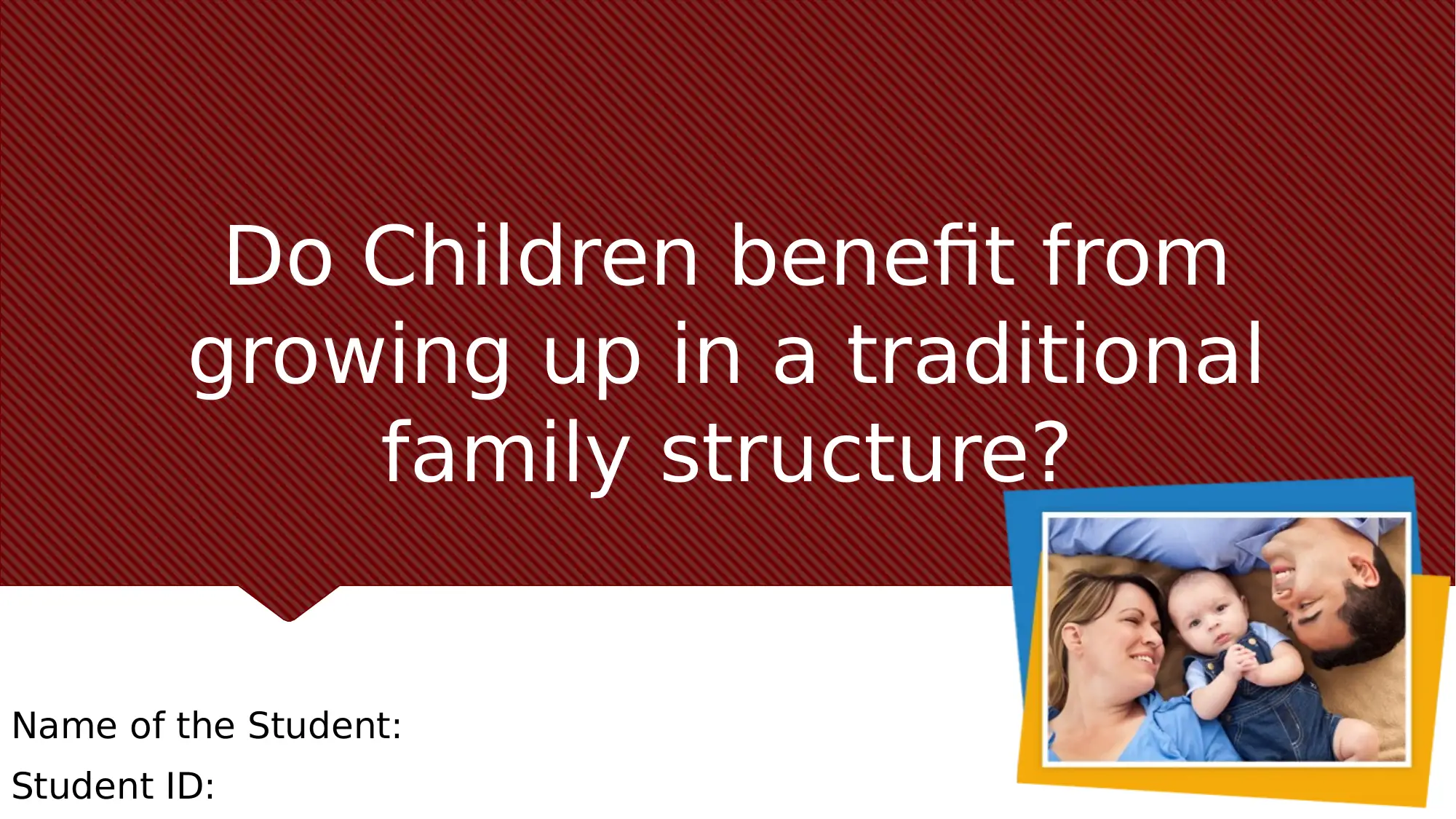
Do Children benefit from
growing up in a traditional
family structure?
Name of the Student:
Student ID:
growing up in a traditional
family structure?
Name of the Student:
Student ID:
Paraphrase This Document
Need a fresh take? Get an instant paraphrase of this document with our AI Paraphraser
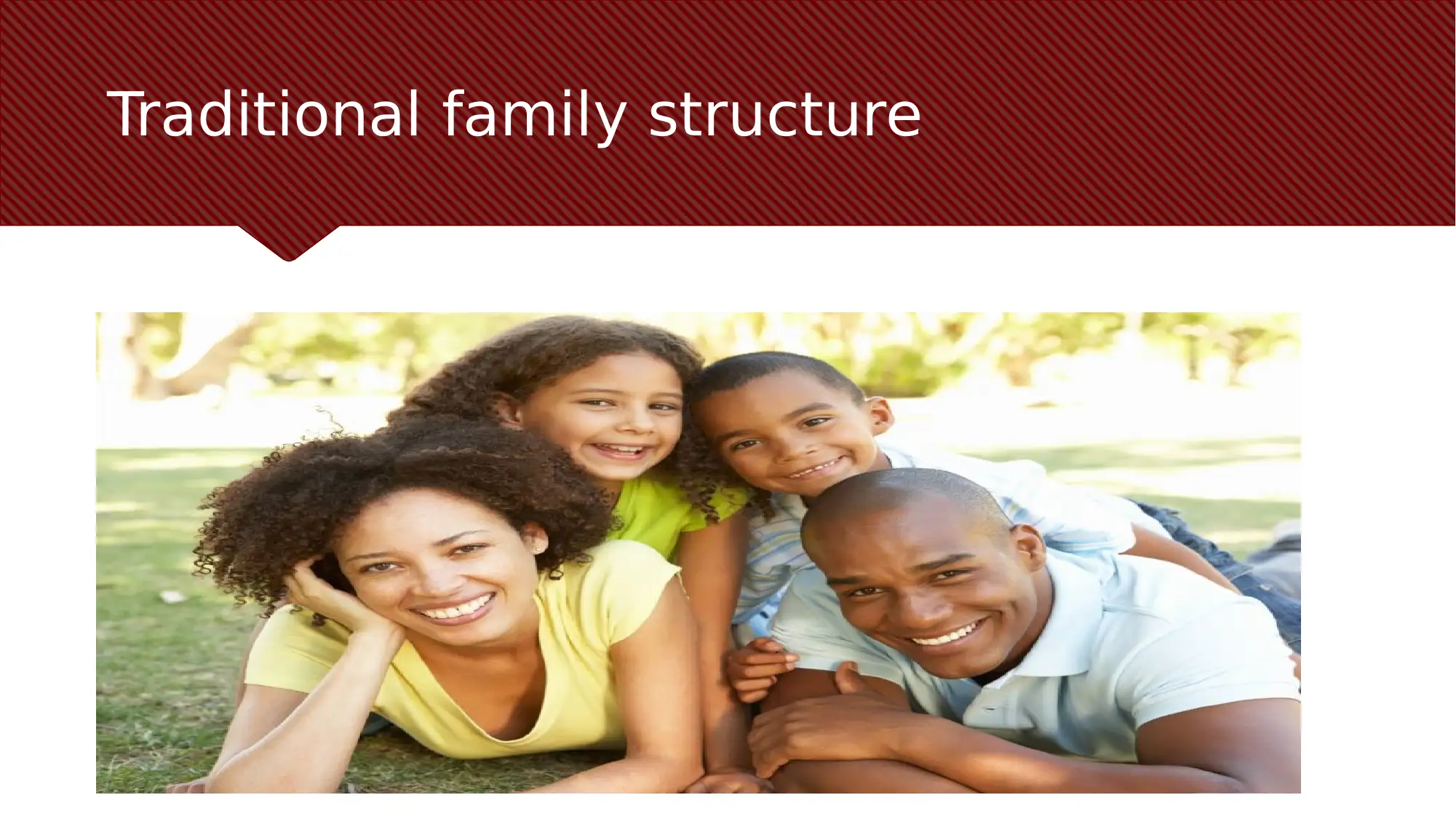
Traditional family structure
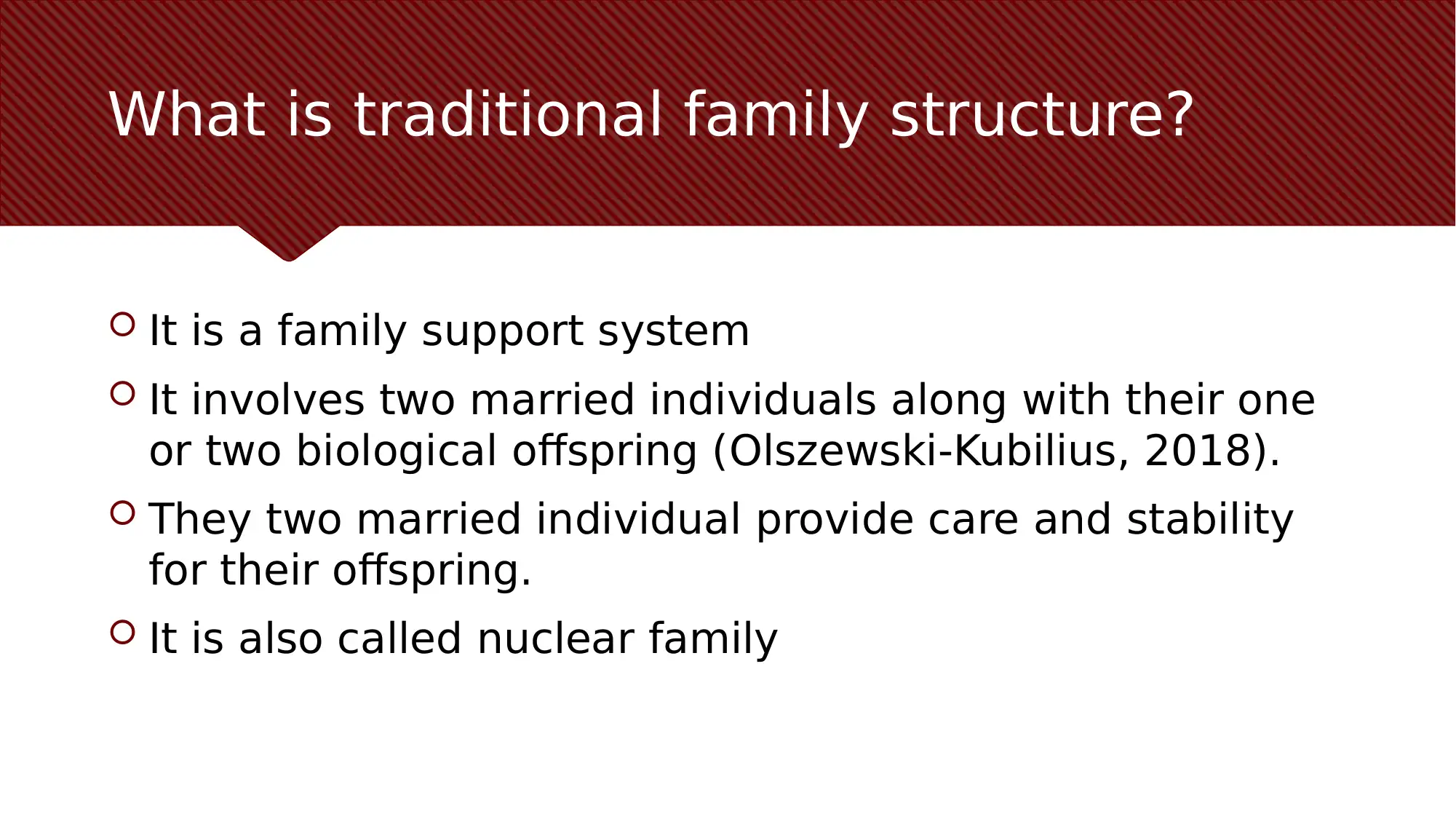
What is traditional family structure?
It is a family support system
It involves two married individuals along with their one
or two biological offspring (Olszewski-Kubilius, 2018).
They two married individual provide care and stability
for their offspring.
It is also called nuclear family
It is a family support system
It involves two married individuals along with their one
or two biological offspring (Olszewski-Kubilius, 2018).
They two married individual provide care and stability
for their offspring.
It is also called nuclear family
⊘ This is a preview!⊘
Do you want full access?
Subscribe today to unlock all pages.

Trusted by 1+ million students worldwide
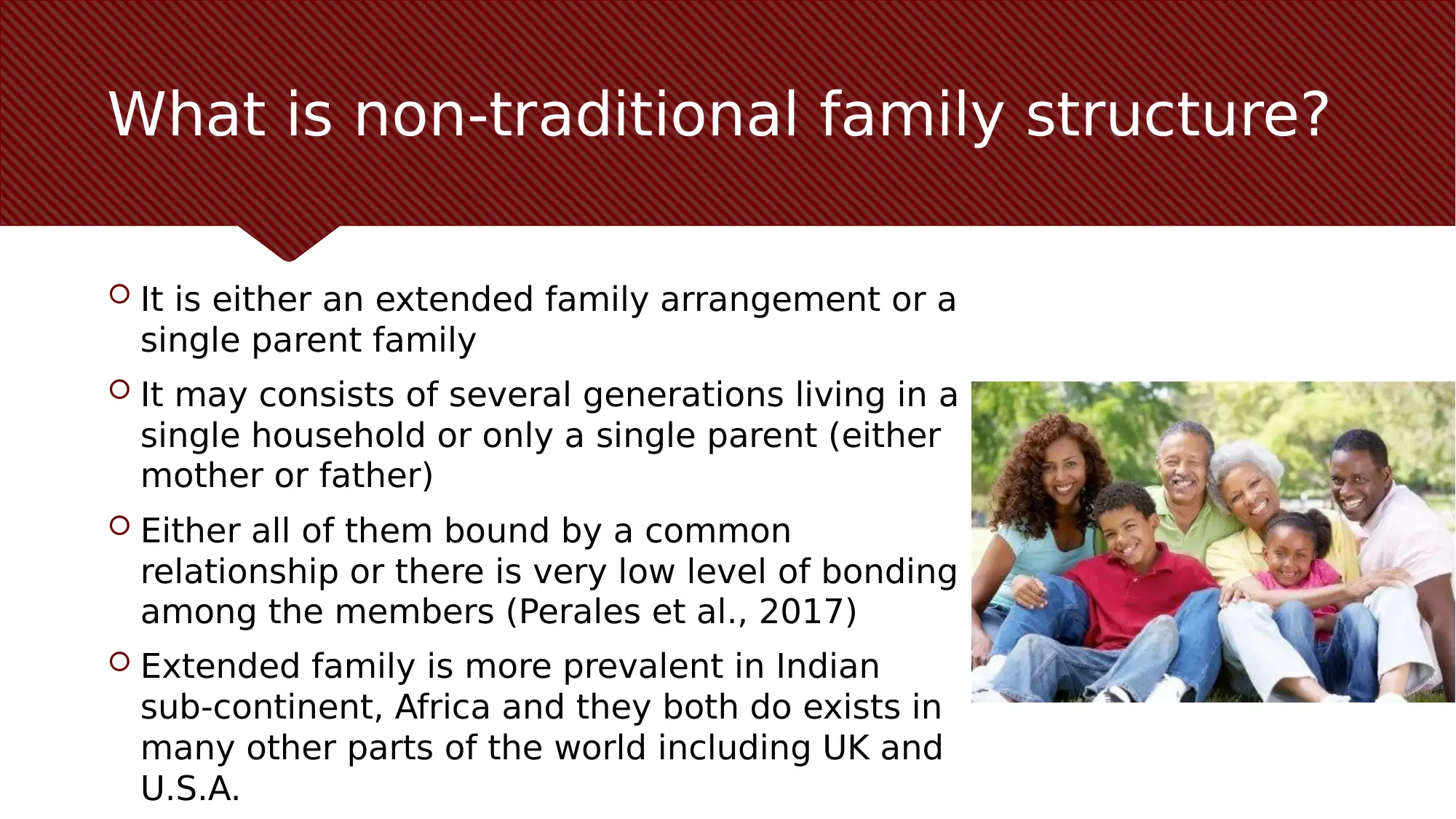
What is non-traditional family structure?
It is either an extended family arrangement or a
single parent family
It may consists of several generations living in a
single household or only a single parent (either
mother or father)
Either all of them bound by a common
relationship or there is very low level of bonding
among the members (Perales et al., 2017)
Extended family is more prevalent in Indian
sub-continent, Africa and they both do exists in
many other parts of the world including UK and
U.S.A.
It is either an extended family arrangement or a
single parent family
It may consists of several generations living in a
single household or only a single parent (either
mother or father)
Either all of them bound by a common
relationship or there is very low level of bonding
among the members (Perales et al., 2017)
Extended family is more prevalent in Indian
sub-continent, Africa and they both do exists in
many other parts of the world including UK and
U.S.A.
Paraphrase This Document
Need a fresh take? Get an instant paraphrase of this document with our AI Paraphraser
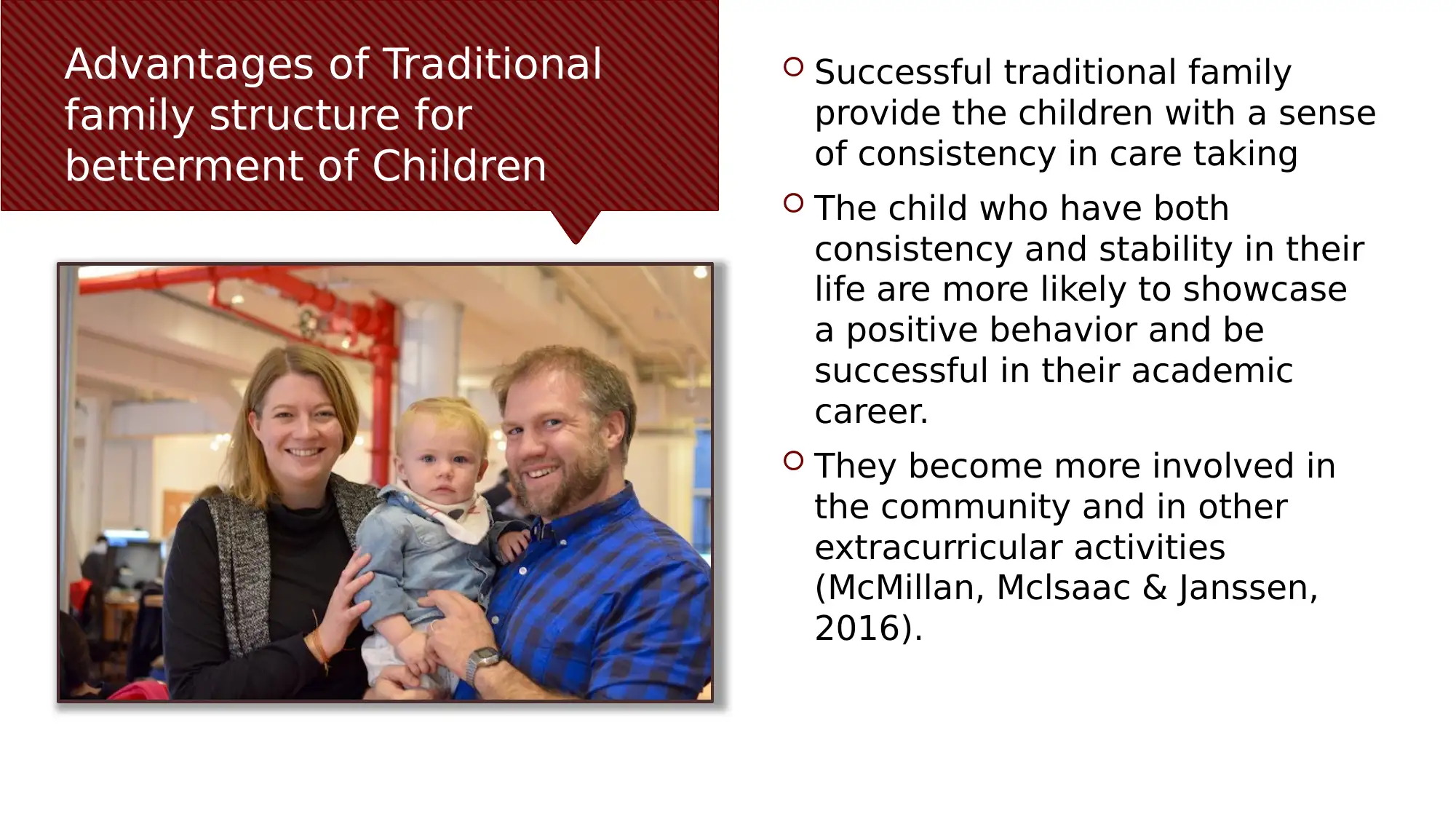
Advantages of Traditional
family structure for
betterment of Children
Successful traditional family
provide the children with a sense
of consistency in care taking
The child who have both
consistency and stability in their
life are more likely to showcase
a positive behavior and be
successful in their academic
career.
They become more involved in
the community and in other
extracurricular activities
(McMillan, Mclsaac & Janssen,
2016).
family structure for
betterment of Children
Successful traditional family
provide the children with a sense
of consistency in care taking
The child who have both
consistency and stability in their
life are more likely to showcase
a positive behavior and be
successful in their academic
career.
They become more involved in
the community and in other
extracurricular activities
(McMillan, Mclsaac & Janssen,
2016).
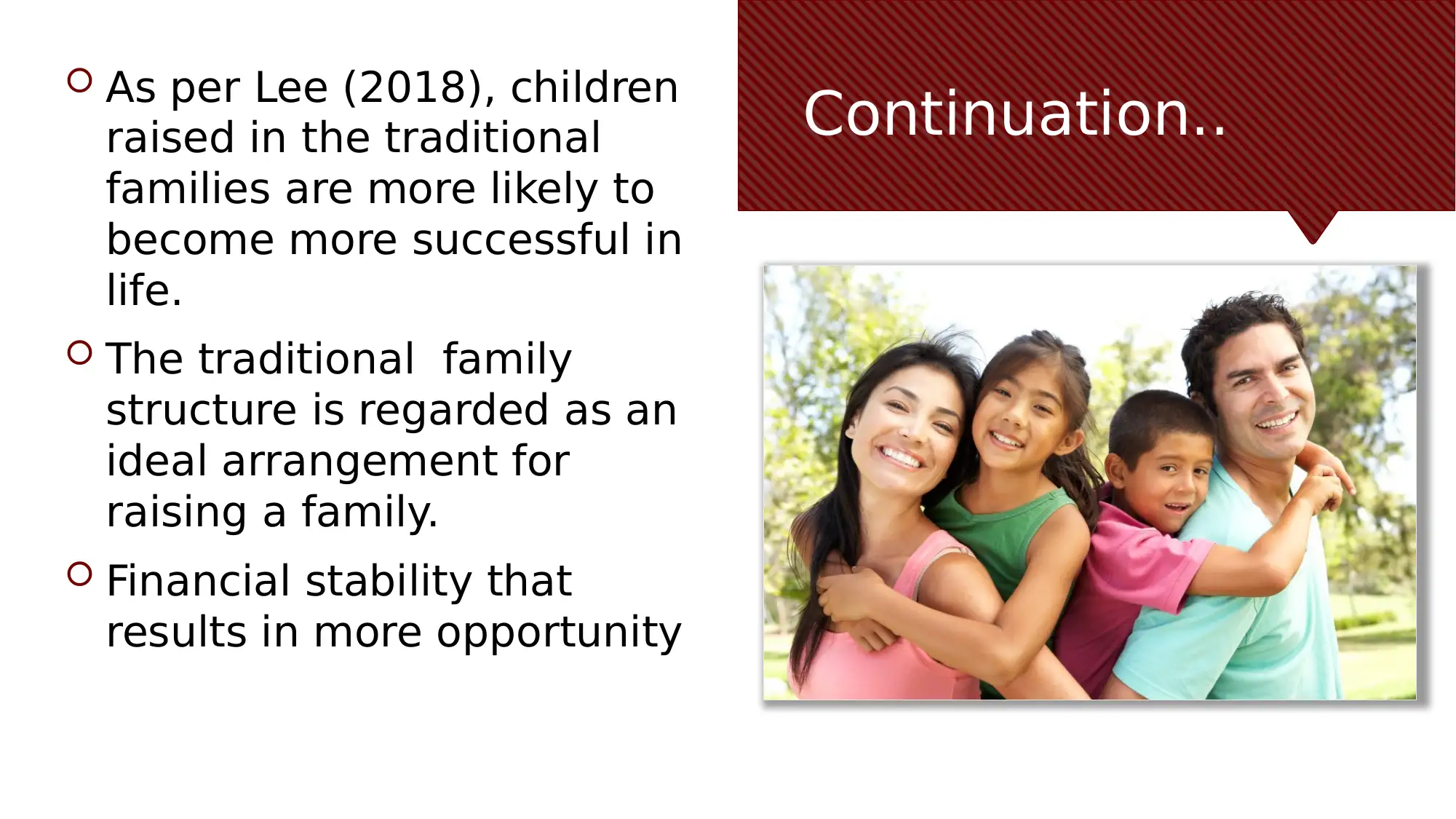
Continuation..
As per Lee (2018), children
raised in the traditional
families are more likely to
become more successful in
life.
The traditional family
structure is regarded as an
ideal arrangement for
raising a family.
Financial stability that
results in more opportunity
As per Lee (2018), children
raised in the traditional
families are more likely to
become more successful in
life.
The traditional family
structure is regarded as an
ideal arrangement for
raising a family.
Financial stability that
results in more opportunity
⊘ This is a preview!⊘
Do you want full access?
Subscribe today to unlock all pages.

Trusted by 1+ million students worldwide
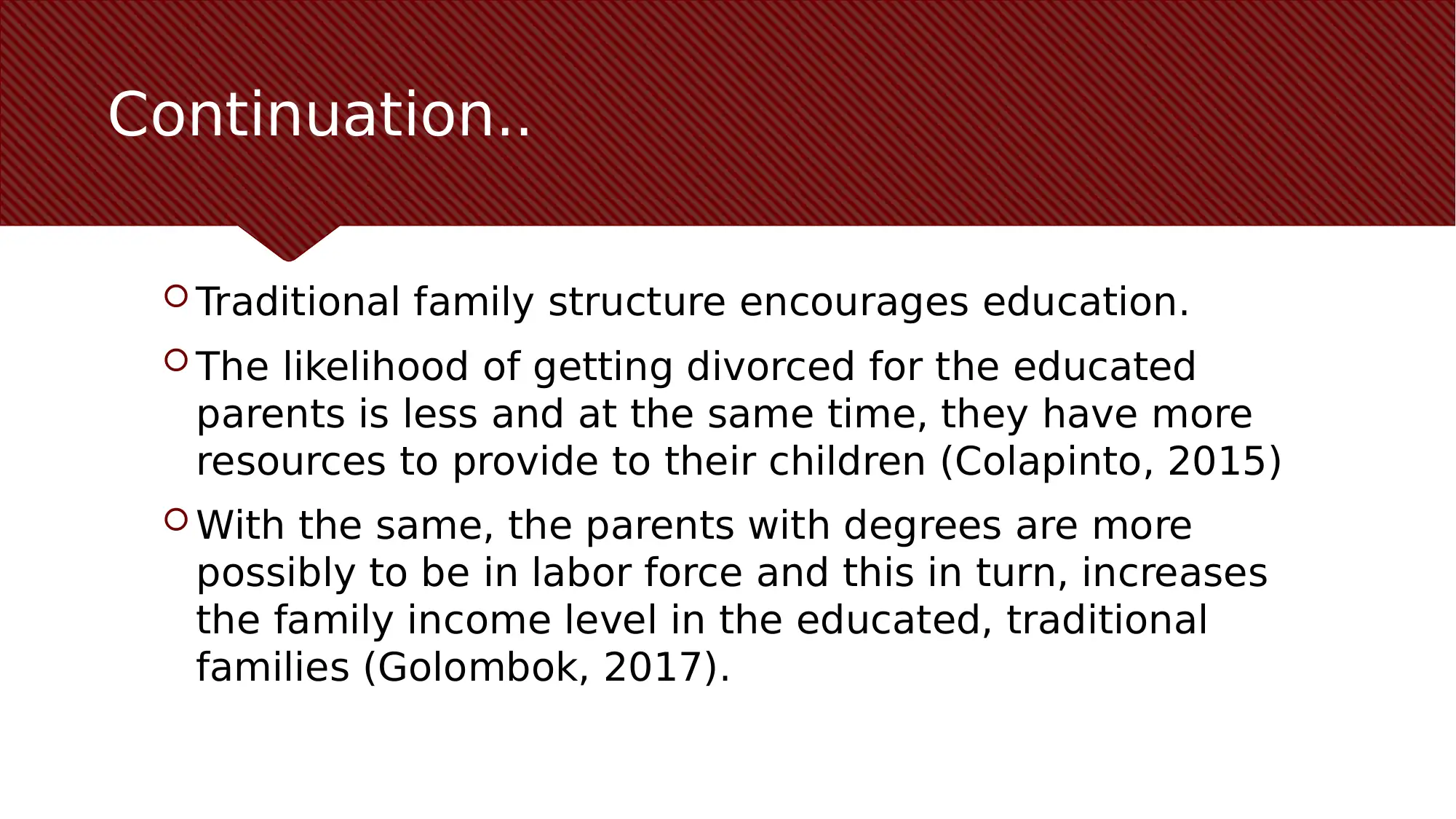
Continuation..
Traditional family structure encourages education.
The likelihood of getting divorced for the educated
parents is less and at the same time, they have more
resources to provide to their children (Colapinto, 2015)
With the same, the parents with degrees are more
possibly to be in labor force and this in turn, increases
the family income level in the educated, traditional
families (Golombok, 2017).
Traditional family structure encourages education.
The likelihood of getting divorced for the educated
parents is less and at the same time, they have more
resources to provide to their children (Colapinto, 2015)
With the same, the parents with degrees are more
possibly to be in labor force and this in turn, increases
the family income level in the educated, traditional
families (Golombok, 2017).
Paraphrase This Document
Need a fresh take? Get an instant paraphrase of this document with our AI Paraphraser
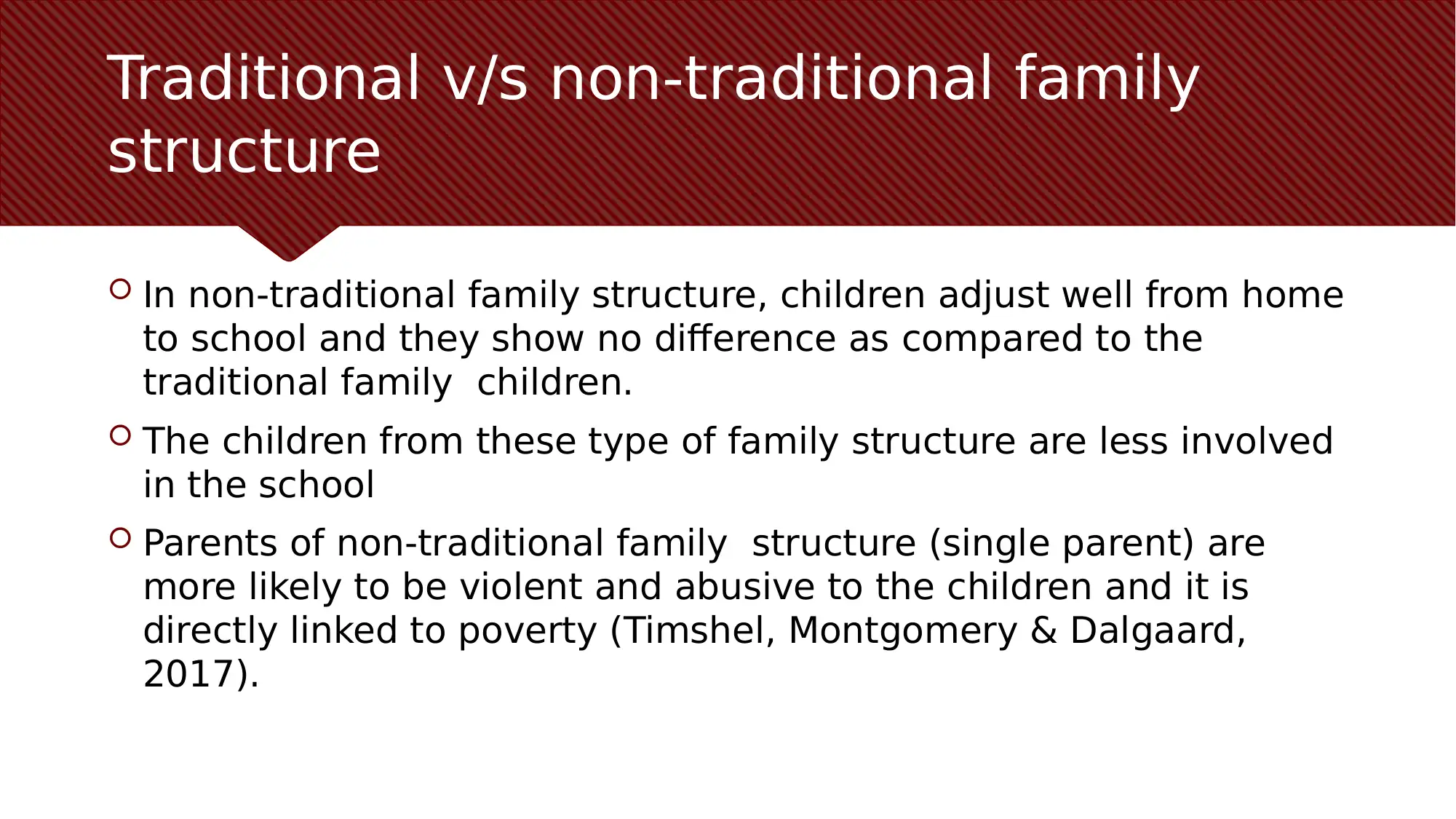
Traditional v/s non-traditional family
structure
In non-traditional family structure, children adjust well from home
to school and they show no difference as compared to the
traditional family children.
The children from these type of family structure are less involved
in the school
Parents of non-traditional family structure (single parent) are
more likely to be violent and abusive to the children and it is
directly linked to poverty (Timshel, Montgomery & Dalgaard,
2017).
structure
In non-traditional family structure, children adjust well from home
to school and they show no difference as compared to the
traditional family children.
The children from these type of family structure are less involved
in the school
Parents of non-traditional family structure (single parent) are
more likely to be violent and abusive to the children and it is
directly linked to poverty (Timshel, Montgomery & Dalgaard,
2017).
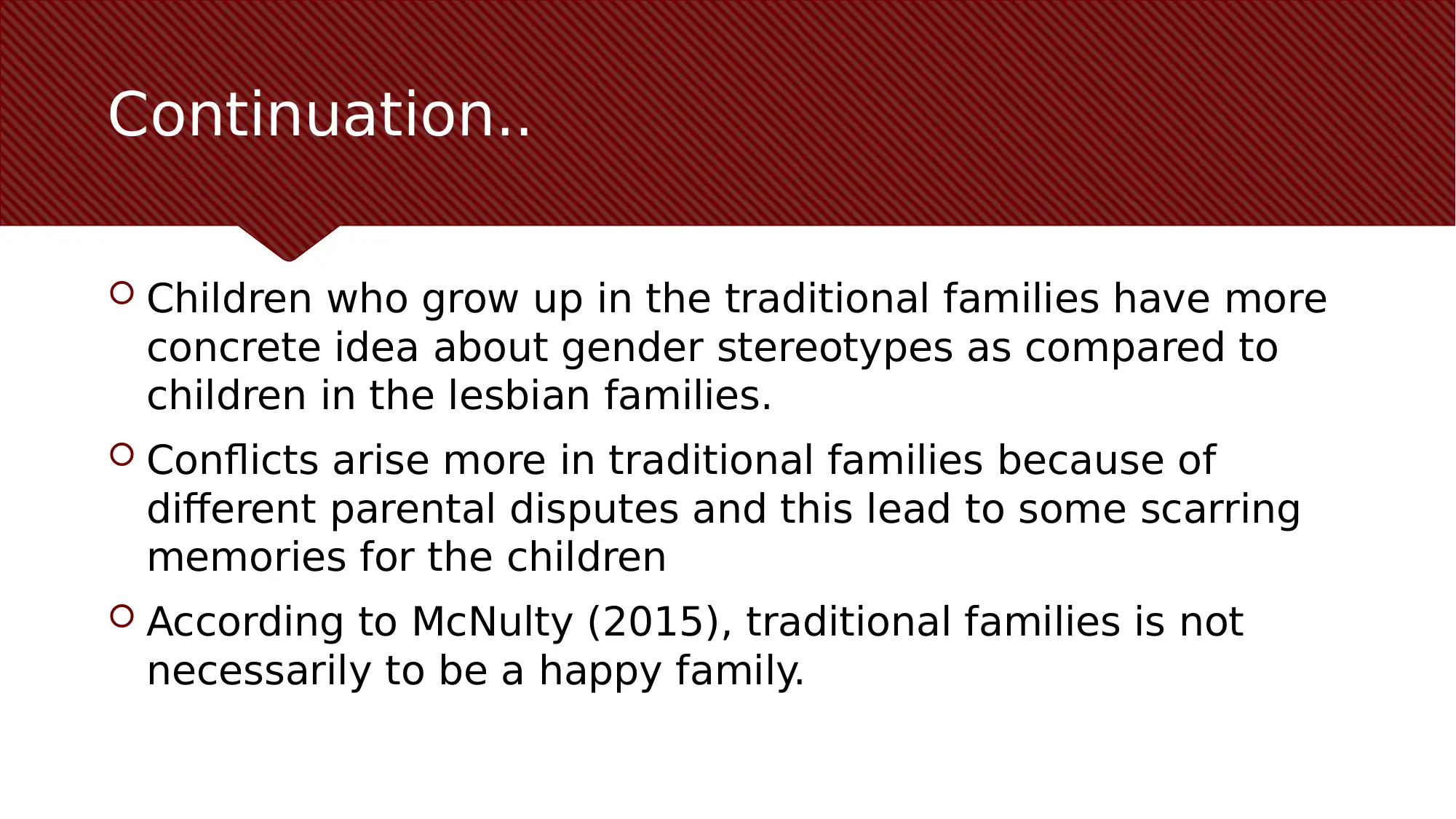
Continuation..
Children who grow up in the traditional families have more
concrete idea about gender stereotypes as compared to
children in the lesbian families.
Conflicts arise more in traditional families because of
different parental disputes and this lead to some scarring
memories for the children
According to McNulty (2015), traditional families is not
necessarily to be a happy family.
Children who grow up in the traditional families have more
concrete idea about gender stereotypes as compared to
children in the lesbian families.
Conflicts arise more in traditional families because of
different parental disputes and this lead to some scarring
memories for the children
According to McNulty (2015), traditional families is not
necessarily to be a happy family.
⊘ This is a preview!⊘
Do you want full access?
Subscribe today to unlock all pages.

Trusted by 1+ million students worldwide
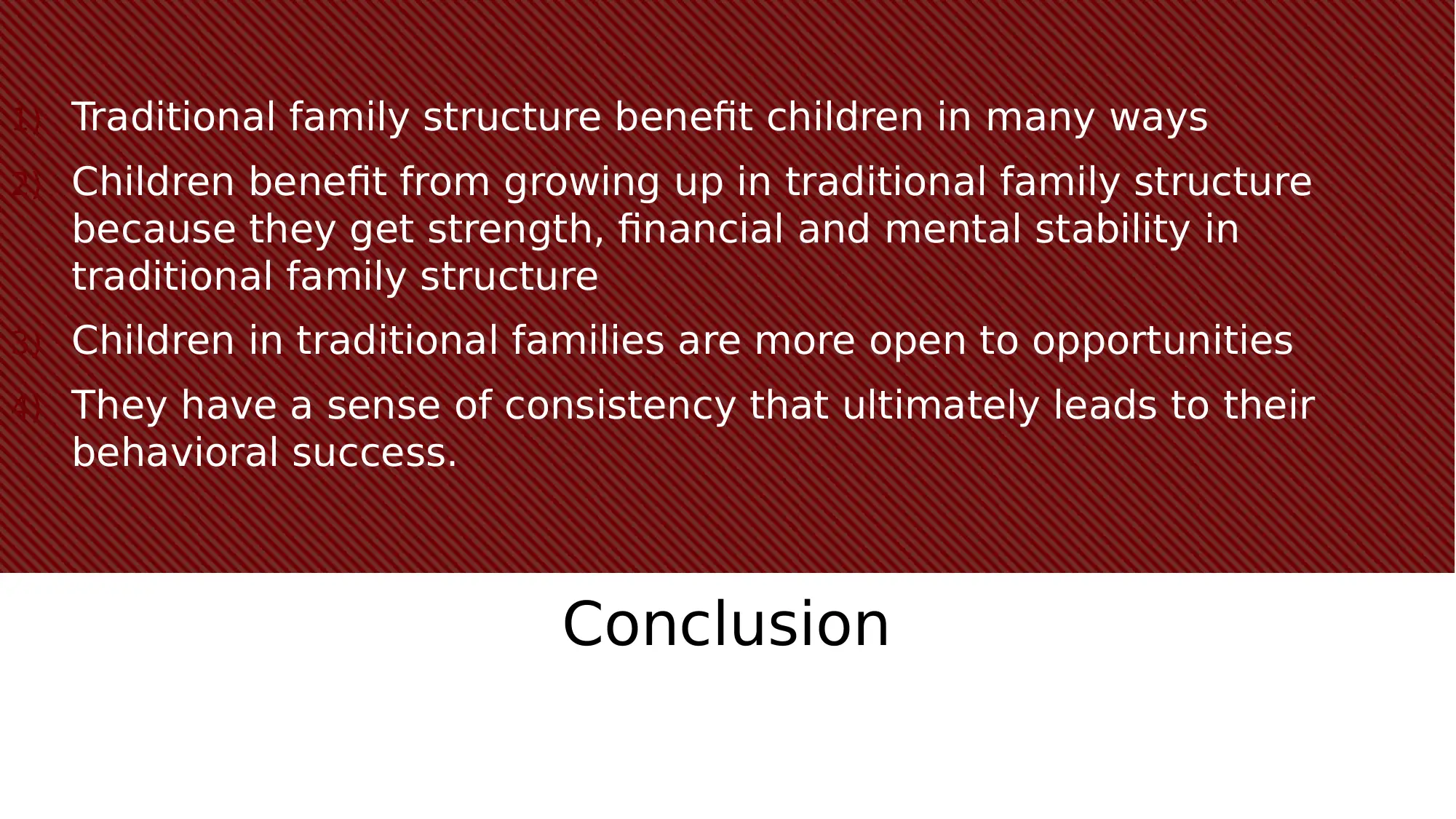
Conclusion
1) Traditional family structure benefit children in many ways
2) Children benefit from growing up in traditional family structure
because they get strength, financial and mental stability in
traditional family structure
3) Children in traditional families are more open to opportunities
4) They have a sense of consistency that ultimately leads to their
behavioral success.
1) Traditional family structure benefit children in many ways
2) Children benefit from growing up in traditional family structure
because they get strength, financial and mental stability in
traditional family structure
3) Children in traditional families are more open to opportunities
4) They have a sense of consistency that ultimately leads to their
behavioral success.
Paraphrase This Document
Need a fresh take? Get an instant paraphrase of this document with our AI Paraphraser
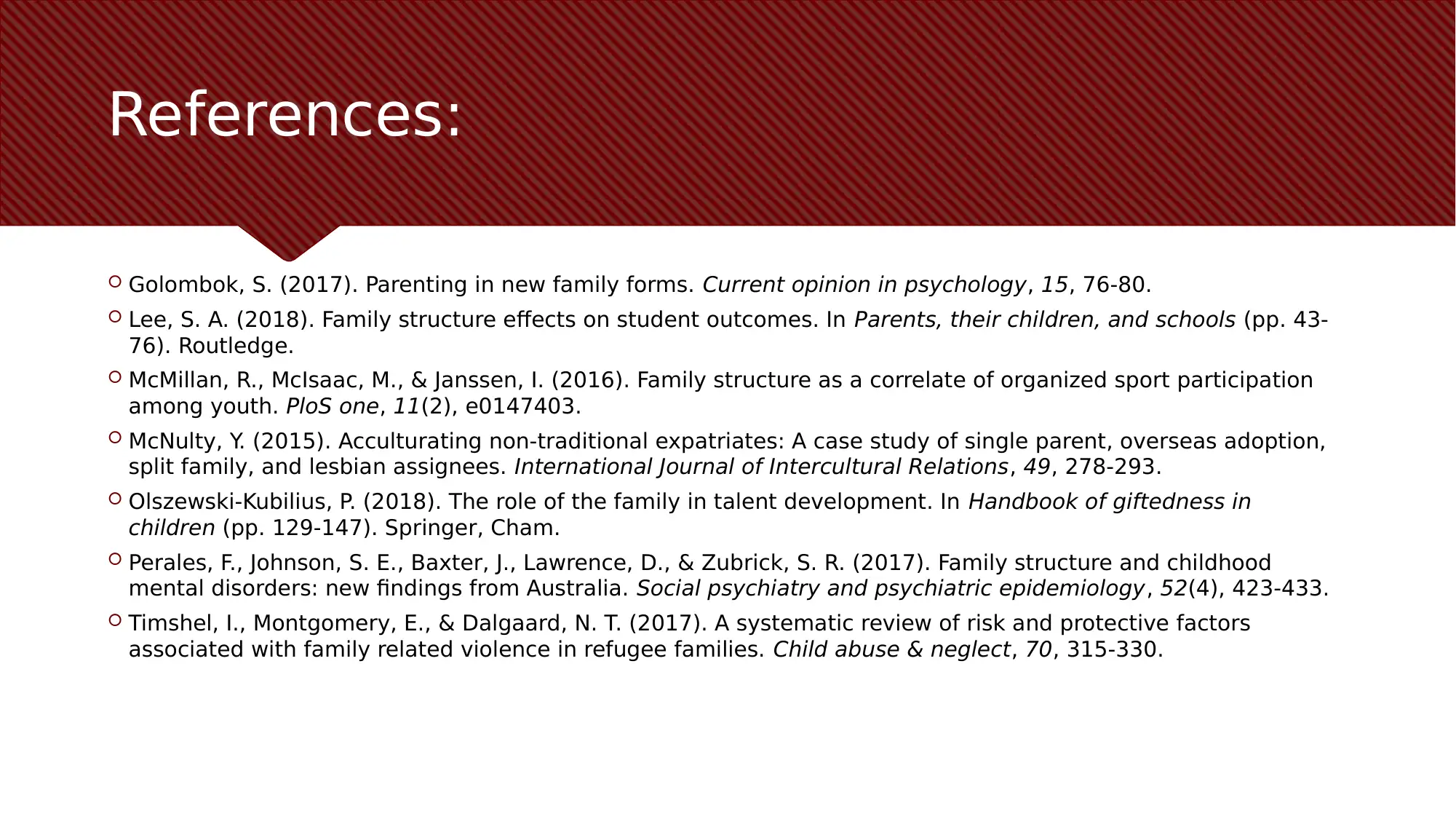
References:
Golombok, S. (2017). Parenting in new family forms. Current opinion in psychology, 15, 76-80.
Lee, S. A. (2018). Family structure effects on student outcomes. In Parents, their children, and schools (pp. 43-
76). Routledge.
McMillan, R., McIsaac, M., & Janssen, I. (2016). Family structure as a correlate of organized sport participation
among youth. PloS one, 11(2), e0147403.
McNulty, Y. (2015). Acculturating non-traditional expatriates: A case study of single parent, overseas adoption,
split family, and lesbian assignees. International Journal of Intercultural Relations, 49, 278-293.
Olszewski-Kubilius, P. (2018). The role of the family in talent development. In Handbook of giftedness in
children (pp. 129-147). Springer, Cham.
Perales, F., Johnson, S. E., Baxter, J., Lawrence, D., & Zubrick, S. R. (2017). Family structure and childhood
mental disorders: new findings from Australia. Social psychiatry and psychiatric epidemiology, 52(4), 423-433.
Timshel, I., Montgomery, E., & Dalgaard, N. T. (2017). A systematic review of risk and protective factors
associated with family related violence in refugee families. Child abuse & neglect, 70, 315-330.
Golombok, S. (2017). Parenting in new family forms. Current opinion in psychology, 15, 76-80.
Lee, S. A. (2018). Family structure effects on student outcomes. In Parents, their children, and schools (pp. 43-
76). Routledge.
McMillan, R., McIsaac, M., & Janssen, I. (2016). Family structure as a correlate of organized sport participation
among youth. PloS one, 11(2), e0147403.
McNulty, Y. (2015). Acculturating non-traditional expatriates: A case study of single parent, overseas adoption,
split family, and lesbian assignees. International Journal of Intercultural Relations, 49, 278-293.
Olszewski-Kubilius, P. (2018). The role of the family in talent development. In Handbook of giftedness in
children (pp. 129-147). Springer, Cham.
Perales, F., Johnson, S. E., Baxter, J., Lawrence, D., & Zubrick, S. R. (2017). Family structure and childhood
mental disorders: new findings from Australia. Social psychiatry and psychiatric epidemiology, 52(4), 423-433.
Timshel, I., Montgomery, E., & Dalgaard, N. T. (2017). A systematic review of risk and protective factors
associated with family related violence in refugee families. Child abuse & neglect, 70, 315-330.

Thank You
⊘ This is a preview!⊘
Do you want full access?
Subscribe today to unlock all pages.

Trusted by 1+ million students worldwide
1 out of 12
Related Documents
Your All-in-One AI-Powered Toolkit for Academic Success.
+13062052269
info@desklib.com
Available 24*7 on WhatsApp / Email
![[object Object]](/_next/static/media/star-bottom.7253800d.svg)
Unlock your academic potential
Copyright © 2020–2025 A2Z Services. All Rights Reserved. Developed and managed by ZUCOL.





